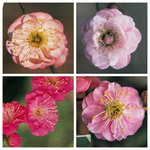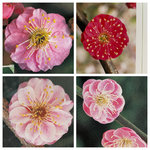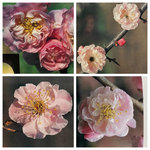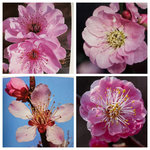leatherback
The Treedeemer
No luck this time around. But I took new cuttings last week. Lets see whether that works.So how did everyone's cuttings fair this year?
No luck this time around. But I took new cuttings last week. Lets see whether that works.So how did everyone's cuttings fair this year?
No you did not.I thought cuttings were taken in the winter ? Did I read wrong?
So how did everyone's cuttings fair this year?

 www.instagram.com
www.instagram.com
Good thorough post! I truely believe grafting is the way to go with Mume. At the end the bark will conceal any grafts and as you mentioned one could easily swap cultivars on the same tree.Cuttings taken during dormancy
My yabai ('standard' plain white Ume) variety rooted VERY quickly. Success rate was around 100%. All of them have pushed at least 8-10 internodes. A small handful of them put on substantial growth by June/July (see Instagram post, link below), but this should not be viewed as the average result. This kind of growth represents 10 out of +500 cuttings for me:

Canada Bonsai on Instagram: "Remember those Ume cuttings? Some are pushing as much 20 internodes 🥰 #canadabonsai #bonsai #ume #japaneseapricot #prunusmume"
188 likes, 3 comments - canadabonsai on June 12, 2021: "Remember those Ume cuttings? Some are pushing as much 20 internodes 🥰 #canadabonsai #bonsai #ume #japaneseapricot #prunusmume"www.instagram.com
As for the cultivars, I can say that about 15 out of 40 cultivars survived and are doing well, but with low success rates (under 10% per surviving cultivar). The success rate for most cultivars was 0%. The surviving cultivars have sent out shoots but are very slow, and some have died over the summer for unknown reasons. (Not to worry, I saved almost all of these cultivars by also grafting them onto rootstock).
Cuttings taken during the growing season
My yabai cuttings taken during the growing season have rooted year-after-year with close to 100% success rate. They root quickly, strongly, and seem healthier overall.
I have not sampled extensively with cultivar cuttings taken during the growing season. I have had success with Hibai and Omoi No Mama. The particular cuttings were taken from scions I had grafted onto rootstock a few months earlier as an experiment. They are alive, but they have pushed a mere 2-3 leaves at most.
Discussion
Cuttings of cultivars, wether during dormancy or during the growing season, turns out to be a misguided approach. During the last 2-3 years I spent a lot of time (and money) finding and sending translators to dedicated Ume growers and pre-bonsai nurseries specializing in Ume, and having books and articles translated (I did this because i am interested in Ume both for bonsai and for fruit-products -- hence the logo). Exactly none of them are producing any of the cultivars via cutting.
Rather, everyone I spoke to created rootstock by producing cuttings of their yabai during the growing season, or and/or they grow from seed. The cultivars are then grafted onto this rootstock, regardless of whether we are talking fruit production, garden ornamentals, bonsai, etc.
For bonsai, understanding how Ume are developed for different aesthetics objectives is crucial. Although it is not possible to review all of the approaches here, it might be worth reviewing some key examples: One approach would be to grow out a trunk (and, optionally, primary branches) using yabai (because of its vigour), and then one can graft the cultivar onto the trunk, primary, secondary and/or the tertiary branches. Consider the 4th attached image. Another approach is told through the 1st and 2nd images: these Ume were each a massive trunk for many years, then two side branches were chosen (likely grafted) as future trunks, and the main trunk was chopped down. Another approach would be to graft them down low, or up high: both of these seem possible if one is aiming for something like the tree in the 3rd image or 4th image. With these examples I am focusing on showing a few of the different moments when cultivars could be introduced into the design of an Ume bonsai, but it in many cases plain white Ume is what see at high-level exhibitions in Japan (which may be neither here nor there).
Having gone through thousands of pictures of Ume (within bonsai and beyond), I cannot imagine a scenario in which one might need to have a cultivar on its own roots. This is especially true because Ume aesthetics permit deadwood, even significant amounts of it. It is also true because Ume cultivation as bonsai necessarily requires grafting to maintain the silhouette over longer periods of time (there are Ume that have been exhibited at Kokufu twice, each time with a different flower cultivar!).
It looks like the concern of having Ume cultivars on their own roots was imported from elsewhere (Japanese maples?), but to my current understanding it is irrelevant when it comes to Ume.
Conclusion
I won't be trying to produce Ume cultivars via cutting any more. As for rootstock, the extreme facility of producing yabai cuttings during the growing season (or starting with seed) makes it necessary to take cutting during dormancy. My current projects involve grafting cultivars low onto rootstock in order to be able to share them with others soon, and growing out yabai trunks that may or may not receive cultivar scions via graft in the decades to come.
That would be great, IMHO, if one had some old gnarly trunks. In fact I think this is what a lot of Japanese mume bonsai are = old trunks with grafted flowering branches. Of course, that presents a problem - I don't have 50 more years to wait for the nice trunk (who does?).Good thorough post! I truely believe grafting is the way to go with Mume. At the end the bark will conceal any grafts and as you mentioned one could easily swap cultivars on the same tree.
In that case you will have to drop the cash to get what you want. I'm just happy growing them. Hopefully my daughter will be able to reap the rewards of all my efforts with my plants....she's 6 nowThat would be great, IMHO, if one had some old gnarly trunks. In fact I think this is what a lot of Japanese mume bonsai are = old trunks with grafted flowering branches. Of course, that presents a problem - I don't have 50 more years to wait for the nice trunk (who does?).
At the end the bark will conceal any grafts and as you mentioned
That would be great, IMHO, if one had some old gnarly trunks. In fact I think this is what a lot of Japanese mume bonsai are = old trunks with grafted flowering branches. Of course, that presents a problem - I don't have 50 more years to wait for the nice trunk (who does?).
the extreme facility of producing yabai cuttings during the growing season (or starting with seed) makes itnecessaryunnecessary to take cutting during dormancy
Just to get it straight......I didn't say this, and I don't think it's true. Many of the cultivars have different bark textures. Look at the 3rd image I attached above (the one with the pink flowers). I'm not going to post images of different trees to illustrate the differences in bark textures because I think age is an important factor which is difficult to verify. It's safer to show this difference above and belowthe graft junction of the same tree.
-Low grafts can be hidden with deadwood if necessary.
-Grafting onto tertiary branches is common, and because the material is only pencil-thick at those locations the reduced surface area of the branch diminishes the degree to which bark patterns are apparent and so too variations in those patterns.
I hear you, and I recognize that '50' was a hyperbole (I think? LOL), but I think they develop faster than people tend to think. I attached two images. The two trees in the first image, and the tree on the left in the second image, are all described as "2 years in the field, 2 years in the pot". Sure, these are only 6" tall and a long way from the 'yardadori' that show up at Kokufu, but I think it reveals a sense of time and pace of development. Of course, the process of growing a stump is also less meticulous if one intends to turn 90% of it into deadwood (as in the third image attached here for example) and so putting the pedal to the floor is the much less of a concern than it is when working with Japanese Maples, for example, especially if one does not care at all what the branches look like (if one intends to remove/replace them all). But I'll have to report back in 5 years to asses if this still makes as much sense to me as it does now
Since I'm posting anyways, I noticed a mistake in my previous post:
Curious what are some of the differences in cultivars? Seems everything I have ever seen is white, pink, or red. Red is never really red but dark pink. Then you have single and double flowers. Is it bark, bloom size, or different colors?
cool, thanks!
- Different type of flowers (single or double)
- Different colors of flowers (white, pink, red)
- Different growth rates
- Different growth habit (upright, weeping, contorted)
- Different wood color (white wood for white flowers and pinkish wood for pink/red flowers)
- Different fruit
- Different bloom time
Curious what are some of the differences in cultivars? Seems everything I have ever seen is white, pink, or red. Red is never really red but dark pink. Then you have single and double flowers. Is it bark, bloom size, or different colors?
Different wood color (white wood for white flowers and pinkish wood for pink/red flowers)










Interesting, easy to see most of the variations with the photos. I wouldn't notice but I also have probably 75 maple cultivars so we all geek out on something.I decided to stay within the pink cultivars (without going far at all into the 'reds'), in order to illustrate the kind of variations that one can expect from Ume. These are all documented cultivars. Among other things, in these images you can't see the variation in size of flower, or density of flowers (how close the flower buds are to each other), or whether the flowers themselves are perky or somewhat droopy.
Especially in the case of white flowered varieties, the color of the sepals is important (see last image). It is not understood whether their color is due to weather/sun, genetic, or a combination of the two. Sepals vary from green to yellow to red. In my opinion, red sepals on white flowers are the most attractive for bonsai, whereas green sepals I would sooner associate with 'youth' (roughly speaking), which contradicts the general aesthetics of Ume. I can imagine a display that captures the youth of Ume where green sepals may be appropriate, but it would be an unusual display I think.
To some, all these pink flowers will all look the same. To others, the variation will be apparent and marvellous. It's a bit like wine.
(It looks like I may have accidentally included the same image more than once!)
This is incorrect. Ume do have different wood (and shoot) colors, but this does not always correspond to flower color.
I also have probably 75 maple cultivars so we all geek out on something
Very interesting although I had to look up etiolation first. Didn't know about this technique...For those really intent on cutting propagation of cultivars, I thought this might be of interest
This book proposes a 'yellowing technique' i.e. etiolation as a pretreatment technique for cutting propagation, as something that may possibly help. This is of course suggested as somewhat of an aside among 32 pages on propagation
